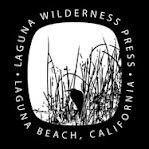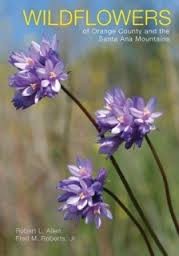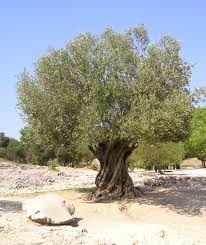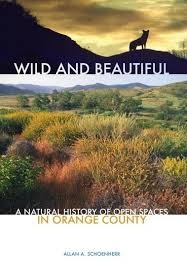
First, I want to put my own enthusiasm as a wannabe naturalist in context and cop, up front, to my total newbie-ism. There are so many other talented book and nature people who should be writing this morning about Laguna Wilderness Press, a great resource for amazing books about our region but, lucky me and thanks to Editor Gustavo the A, you'll have to suffer my excitement and endure this Mr. Bib-come-lately appreciation. It started when I found myself, no kidding, using the wet-dry vac to suck up some of what must be the absolutely most productive default olive “harvest” that has happened in these parts lately, where I live under the weird mixed-up canopy of oaks, sycamores, a few unlikely pines and, yes, hundreds of olive trees which rural (as opposed to urban) legend insists were planted by Madame Helena's boyfriend, the fake Polish “count” about a hundred years ago and, which local lore advises are the “wrong kind” of olive. But as I collected these good-sized full purple-black juicy fruits I wondered what was so wrong about them. The neighborhood in which we reside is not, after all called Wrong Kind Hill.
]
I asked the wonderful Marcella Gilchrist, Site Manager and nature interpreter over at nearby

Tucker Wildlife Sanctuary, run by the good folks of CSU Fullerton. She had forgotten or never knew and, because she is a professional working science interpreter and not, like so many of my neighbors, amateur folklorists and fabulists, did not want to go out on a limb (tree joke, get it?) so instead recommended local experts who could, among them somebody called not at all mysteriously, “Bug Bob” (cuz he is an entomologist) and who, along with his co-author, has produced a remarkable book which, so far, has delighted me if not gotten anybody any closer to figuring out the Mystery of the Wrong Kind of Olive Tree. Here's as good as any a place to offer a photograph of examples of that charming and rare human specimen found, I am told, in the wilds of OC. These two answer to botanist, artist, author, entomologist, instructor or photographer. Both are locally grown, locally educated, with impressive CVs, and the title of their gorgeous 500-page book from, yes, the estimable Laguna Wilderness Press, is Wildflowers of Orange County and the Santa Ana Mountains.


Meanwhile, no European olive trees, which should be pruned and kept small — not, like the feral ones in Modjeska Canyon, nearly 30 feet high — in the wildflower book, and no progress on actually identifying the perhaps problematic (or not) olive fruit which got me started on this little trip.
But on a post-storm hike yesterday morning down to observe the sawed up corpus of an old oak which came down, II observed that recently planted olive trees produce a much different cultivar, the ones that look, pleasingly, like the delicious varieties featured in a book recommended somewhere on my research hike by local Silverado branch librarian Ruth Loc. It's called The Olive in California: History of an Immigrant Tree, and is a beautiful and authoritative text by Judith M. Taylor, medical doctor and amateur botanist with a passion for olive trees.
But, as they say, I digress. And that is the wonderful experience of the natural history book by Roberts and Allen, which I recommend, as do the California Native Plant Society, Laguna Canyon Foundation and Sea N Sage Audubon, each of whose imprimatur is celebrated with their lovely logos on the title page. Each page and photograph demands that you post-it or dog-ear even as you follow your eye to another. Books as these are no doubt expensive to produce, so that those three organizations help make them happen by way of organizational sponsorship from people who care, and care to learn and preserve. What a great model, if likely the only way to publish these beautiful volumes in the book biz. I guess you could say these folks work together across biotic zonation in our region. Wow, see what I did there? Yup, one of the best parts about knowing something about what you might find wildflower-wise, is knowing where to look, and what you are looking at. So i you are my pal or neighbor be prepared for me dropping some phrases that help us all feel like we know what we are looking at and talking about and trying to save from the 'dozers: lowland riparian woodland, vernal pool, coastal salt marsh, foothill riparian woodland, coastal sage scrub, alluvial scrub, photographs of all of which appear in the book. They say it's never too late to have a happy childhood, and they are wrong. I don't want a childhood. I want an adulthood. Well, sort of. Either way, it's never too late to learn something about plant communities, even while you are identifying wildflowers with funny dirty names.
Apologies to those who already know this, and thanks to Marcella, again, but as long as I am digressing, or boostering, I'll mention another text from LWP I should have known about, owned, and written about here some months ago when it came out: Wild and Beautiful: A Natural History of Open Spaces in Orange County. If you type its title into Google you will get a lovely African American woman with great hair, but scroll down a bit and find this “resource valuable to both

the reader in the comfort of their home and the hiker ascending up the trail.” I wish I had written that bit of copy, if only to never have to write it again. Still, I was happy to find that my comfortable home library already included a copy of author Allan A. Schoenherr's previous volume, a field guide called A Natural History of California, from the terrific series put out by UC Press.
Both of these terrific recent books from LWP seem pretty representative of the amazing work done by that organization, with a mission informed by both a scientific and preservationist ethos. Founded in 2003 by three smart, brave local dudes with all kinds of professional and academic credits, the combination of photographic skill and environmentalist politics makes you want to buy a copy or two or three for the holidays for your friends, and “friend” the organization on Facebook, and check out its website for events surrounding these and future publications.
Wild and Beautiful: A Natural History of Open Spaces in Orange County, Alan Schoenherr, Laguna Wilderness Press, 232 pages, $24.95
Wildflowers of Orange County and the Santa Ana Mountains, Robert L. Allen and Fred Mr. Roberts, Jr., Laguna Wilderness Press, 512 pgs, $35.00
The Olive in California: History of an Immigrant Tree, Judith M. Taylor, M.D. Ten Speed Press, out of print but available used.
Andrew Tonkovich hosts the Wednesday night literary arts program Bibliocracy Radio on KPFK 90.7 FM in Southern California.






